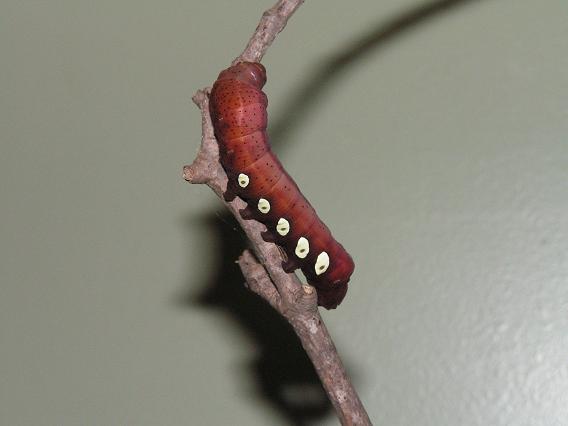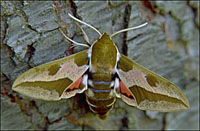|
|
Inspired by and dedicated to Kathy and Kylie Ross, August 2006
Updated as per James P. Tuttle's The Hawk Moths of North America, July 6, 2010
Updated as per BAMONA, July 26, 2019;
|
Benton County, Minnesota, and Nearby Counties:
Morrison; Mille Lacs; Kanabec; Chisago
Sphingidae

Eumorpha pandorus, Benton County, Minnesota, courtesy of
Kathy and Kylie Ross.
This page is inspired by and dedicated to
Kathy and Kylie Ross who sent me the image of the
Eumorpha pandorus larva, top of the page, from Benton County.
Kathy writes, August 5, 2006,
"Hi Bill,
"I will take credit for the photo, but my five year old daughter Kylie, was the one who spotted the caterpillar. She pulled the
Virginia Creeper vine out of the ground and brought it inside to show me... It was exciting for all of us!
"Unfortunately while we were at the lake today, the larva crawled out of the container we had it in. I followed the trail of droppings but
was unable to find where it ended up. Do they over-winter in the ground to emerge in the spring, or should I be watching for the moth
sometime later this fall?
"I'm curious about how common they are in the area that I live. Do you document that kind of thing?
"Again I am very thankful for your information and will keep you in mind if I have other questions about other critters that the kids and
I run across. You've been very, very helpful!"
Eumorpha pandorus is not often seen in or reported from Minnesota. It is much more common in the eastern
United States and generally at lower latitudes.
Your caterpillar will excavate a subterannean cavity in which to pupate and will emerge the following spring/summer, probably in late June to early July.
I have received very few reports of this species in Minnesota.
Twelve Sphingidae species are listed for Minnesota on the U.S.G.S. (now BAMONA) website. Not all of the species are reported or anticipated in
Benton County (only one, Hyles lineata is reported on U.S.G.S. as of 2006). It is hoped that this checklist, with the thumbnails
and notes, will help you quickly identify the moths you are likely to encounter.
A "WO" after the species name indicates that I have no confirmed reports of this species in your county, but I
(William Oehlke) expect that this moth is present or might be present. I have included many species not on the
USGS list for Minnesota; I believe they are or might be present. Many, that are not on the
USGS list, have been confirmed by Tom Middagh for Minnesota.
A "USGS" indicates the moth is reported in Lepidoptera of North America,
#1. Distribution of Silkmoths (Saturniidae) and Hawkmoths (Sphingidae) of Eastern North America,
an excellent little booklet available through Paul Opler.
Please help me develop this list with improved, documented accuracy by sending sightings (species, date, location), preferably with an
electronic image, via email to Bill Oehlke.
Although this checklist was originally created for Benton County, it also serves as a valid checklist for the following counties:
Chisago: Ceratomia amyntor; Paonias excaecata; Hemaris thysbe; Darapsa myron; Hyles gallii; Hyles lineata;
Morrison: Pachysphinx modesta; Hyles lineata;
Kanabec: Ceratomia amyntor; Smerinthus cerisyi;
Mille Lacs: none reported as of July 6, 2019.
Visit Minnesota Catocala: Underwing Moths.
Visit similar checklists at Sphingidae of the Americas where there are checklists for every state in US, every province in Canada;
Mexico, all countries in Central and South America.
Sphinginae subfamily
Sphingini tribe:
 |
Agrius cingulata,
WO Pink-spotted hawkmoth,
fall stray
This species is a strong migrant and adults nectar from
deep-throated flowers including moonflower (Calonyction aculeatum),
morning glory (Convolvulus), honey suckle (Lonicera)
and petunia (Petunia species). unlikely
|
 |
Ceratomia amyntor
WO/Chisago/Kanabec,
the Elm Sphinx or Four-horned Sphinx
The upperside of the forewing is brown with dark brown and white
markings including a white costal area near the wing base, dark
streaks along the veins, and a white spot in the cell.
Larvae feed on Elm (Ulmus), birch (Betula), basswood (Tilia), and
cherry (Prunus). |
 |
It is named for the wavy lines on the forewings.
Note black and white collar separating thorax from abdomen. |
 |
Reported from northern Minnesota and central western Wisconisn,
it might be present in Benton County. This is one we have on P.E.I.
|
 |
Manduca quinquemaculata
WO the Five-spotted Hawkmoth
The moth abdomen usually has five but sometimes six pairs of yellow bands. The upperside
of the forewing is blurry brown and gray. If you
grow tomatoes, you have probably encountered it.
|
 |
If you grow tomatoes, you have probably encountered Manduca sexta
in the larval stage.
Larvae get very large and can strip a tomato plant.
generally a more southerly species
|
 |
Sphinx chersis
WO, the Northern Ash Sphinx or Great Ash
Sphinx
The upperside of the forewing is soft dark gray to
blue-gray with a series of black dashes, one of which reaches the
wing tip.
Larval hosts are ash, lilac, privet, cherry, and quaking aspen.
|
 |
Forewings, long and slender,
are held close to the body when the moth is at rest.
We have
them on P.E.I., but I do not see them frequently. |
 |
The lower forewings are predominantly brownish-yellow with a fairly
wide dark bar along the inner margin. At rest the wings hug the body,
giving the moth a long slender look.
|
Smerinthini Tribe:
 |
This moth is also fairly widely reported to the east and south
and might be present.
This is the first Sphinx species I reared as a boy in New Jersey.
See the file for the female; she is different. |
 |
Pachysphinx modesta
WO/Morrison,
the Modest Sphinx or Poplar Sphinx
This moth is also found in Canada. Moths have very heavy bodies.
Larvae eat poplar and willow. |
 |
Named for the dull grey-blue spot in the hindwing, this moth has a
very wide distribution.
I regularly see them on Prince Edward Island. |
 |
Named for the small eye-spot in the hindwing, this moth has a
very wide distribution.
I regularly see them on Prince Edward Island, and they are reported
as far south as Florida.
|
 |
Smerinthus jamaicensis closely resembles Smerinthus cerisyi,
but jamaicensis is much smaller with larger blue patches on more
vibrant and deeper purple in the lower wings.
|
Macroglossinae subfamily
Dilophonotini tribe:
 |
The abdomen has very distinct gray and black bands.
Adults nectar at dusk so you may see them in the garen at that time.
possibly only as a very rare fall stray
|
 |
Hemaris thysbe
WO/Chisago, the Hummingbird Clearwing
This interesting day flier is not confirmed for Benton County.
They are widely distributed in the east from P.E.I. to Florida. |
See Hemaris comparisons.
 |
Hemaris diffinis
WO, the Snowberry Clearwing or Bumblebee Moth
This moth is widely distributed and
might be present in Benton County.
|
See Hemaris comparison
Philampelini tribe:
 |
Larvae get large and feed on grape vines and Virginia creeper.
|
 |
If you have Grape or Virginia Creeper nearby, then you probably have
this species.
I often get asked to identify larvae from areas not
previously reported. |
Macroglossini tribe:
 |
This day flier is widely distributed. If you have Virginia Creeper, you
might have the Nessus Sphinx. Two bright, distinct, narrow yellow
bands are often visible on the abdomen. generally more southerly
|
 |
Darapsa myron
WO/Chisago, the Virginia Creeper Sphinx or the
Grapevine Sphinx
If you have the foodplants indicated in the common names, you
probably have this species nearby. The lower wings are orange.
|
|
 |
The moth's outer margin of the forewing is deeply scalloped.
The upperside is light brown with dark brown markings.
There is a small black and white spot near the tip.
Grape (Vitis), ampelopsis (Ampelopsis), and Virginia creeper
(Parthenocissus) all serve as larval hosts.
|
 |
Hyles euphorbiae
WO, the Spurge Hawk Moth
The body is light brown with various white and dark brown
markings, while the wings have a conspicuous tan, brown, and pink or
red color pattern.
|
 |
Hyles gallii
WO/Chisago, the Bedstraw Hawk Moth
or Gallium Sphinx
This species is not reported in Minnesota, but I expect it is present.
Some years I see them on P.E.I., some years, I do not.
|
 |
Hyles lineata
USGS/Chisago/Morrison, the White-lined Sphinx
It is a strong migrator from the south,
and there are records from the east and from the west. |
|
Use your browser "Back" button to return to the previous page.
Enjoy some of nature's wonderments, giant silk moth cocoons.
These cocoons are for sale winter and fall. Beautiful Saturniidae moths will emerge the following spring and summer.
Read Actias luna rearing article.
Additional online help available.
Eggs of many North American species are offered during the spring and summer. Occasionally
summer Actias luna and summer Antheraea polyphemus cocoons are available. Shipping to US destinations is done
from with in the US.
Use your browser "Back" button to return to the previous page.
This page is brought to you by Bill Oehlke and the
WLSS. Pages are on space rented from Bizland. If you would like to become a "Patron of the Sphingidae Site", contact Bill.
Please send sightings/images to Bill. I will do my best to respond to requests for identification help.
 | 
Show appreciation for this site by clicking on flashing butterfly to the left.
The link will take you to a page with links to many insect sites. |





























